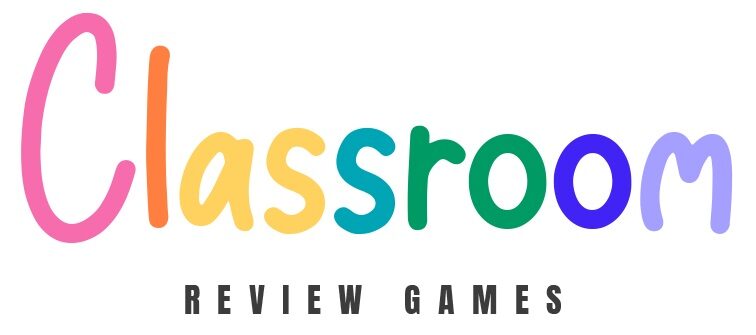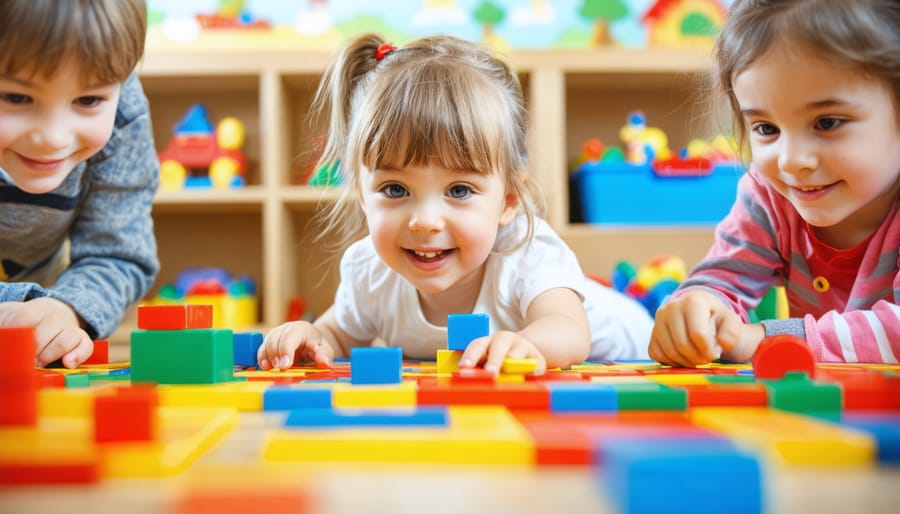Educational Games That Make 5-Year-Olds Love Learning
Transform your classroom into a dynamic learning playground with educational games that captivate 5-year-olds while building essential skills. At this crucial developmental stage, children learn best through play-based activities that combine movement, sensory engagement, and social interaction. Strategic game-based learning not only enhances cognitive development but also nurtures emotional intelligence and social skills.
From simple counting games with colorful manipulatives to interactive digital puzzles that teach letter recognition, age-appropriate educational activities create natural learning opportunities that feel like play. Whether you’re leading a full classroom or working with small groups, these carefully selected games adapt to different learning styles while maintaining the perfect balance of challenge and achievement.
By incorporating both structured and free-play elements, these engaging activities help five-year-olds develop crucial kindergarten readiness skills while fostering a genuine love for learning. Let’s explore proven games that turn everyday lessons into memorable adventures.
Why Educational Games Work for 5-Year-Olds
Developmental Milestones at Age 5
Five-year-olds are at an exciting developmental stage where they’re rapidly gaining new skills and abilities. Cognitively, they can count to 10 or higher, recognize letters and numbers, and understand basic patterns. Their attention span is growing, typically lasting 10-15 minutes for focused activities.
Socially, five-year-olds are becoming more independent and enjoy cooperative play. They understand taking turns, can follow simple rules, and show interest in friendships. Their emotional awareness is expanding, making them more capable of expressing feelings and showing empathy.
Physical development is also flourishing at this age. Most five-year-olds can hop, skip, and balance on one foot. Fine motor skills are improving, allowing them to hold pencils correctly, cut with scissors, and draw recognizable shapes and figures.
These milestones make five-year-olds ready for more structured learning activities while still needing plenty of playful, hands-on experiences to support their development.
Learning Through Interactive Play
When children engage in learning through play, they absorb new concepts naturally and enthusiastically. Games create an environment where children feel safe to explore, make mistakes, and try again without fear. For 5-year-olds, this interactive approach taps into their natural curiosity and energy, making learning feel less like work and more like fun.
Through games, children develop multiple skills simultaneously. While counting spaces on a board game, they’re strengthening number recognition and basic addition. When following game rules, they’re building listening skills and understanding sequence. Even simple matching games help develop memory, concentration, and pattern recognition.
The beauty of game-based learning lies in its ability to keep children engaged while they practice essential skills. When children are having fun, they’re more likely to stay focused and retain information, making games an invaluable teaching tool in any classroom setting.
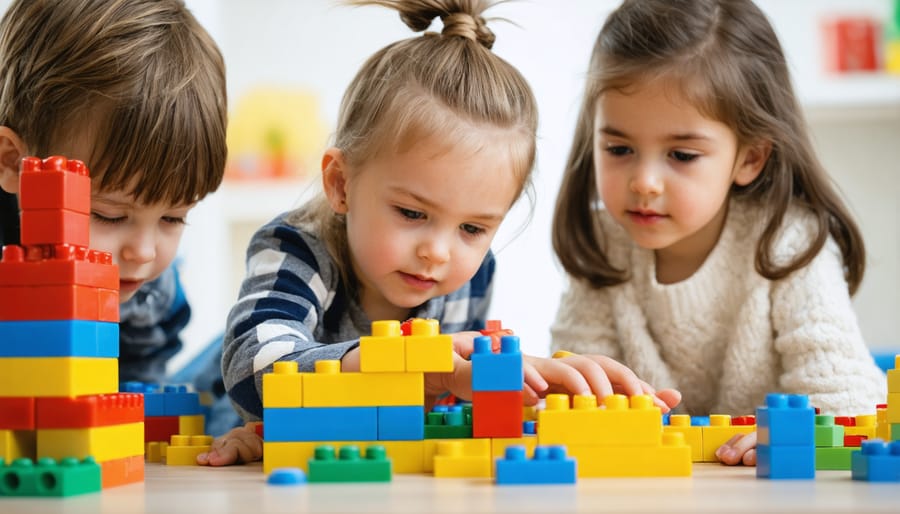
Digital Learning Games That Engage
Math and Numbers Games
Number recognition and basic math concepts come alive through engaging games that make learning fun for 5-year-olds. Simple counting games like “Count and Jump” get kids moving as they count each hop, combining physical activity with number practice. “Number Hunt” transforms your classroom into an exciting adventure zone where students search for hidden number cards and match them to quantity cards.
Digital options like interactive counting apps provide instant feedback and colorful animations that keep young learners engaged. Try setting up “Math Shopping” stations where children can practice counting play money and matching prices to items. Pattern games using colorful blocks or shapes help develop early algebraic thinking while keeping kids entertained.
For group activities, “Circle Time Counting” encourages participation as children count together and take turns adding or subtracting objects from a central collection. Don’t forget classic board games like Hi Ho! Cherry-O, which naturally incorporate counting and basic addition/subtraction concepts. These games can be easily modified to match different skill levels and can be played in small groups or learning centers.
Remember to rotate games regularly to maintain interest and gradually increase complexity as children master basic concepts.
Early Reading and Letter Recognition
Letter recognition games are a fantastic way to build early literacy skills in your classroom. Try the classic “Letter Hunt” where students search for hidden alphabet cards around the room – it gets them moving while learning! Another crowd-pleaser is “Sound Match,” where kids pair objects with their beginning letters, like matching a banana picture to the letter ‘B’.
Digital tools can be equally effective. Interactive alphabet apps let students trace letters while hearing their sounds, reinforcing both visual and auditory learning. For hands-on learners, create a sensory letter bin filled with sand or rice where children can practice writing letters with their fingers.
Make reading practice fun with “Word Family Houses” – simple drawings of houses where students group rhyming words together. The roof might show ‘-at’ while students add cards with ‘cat’, ‘hat’, and ‘rat’ in the house body. This activity works great in small groups or as an independent center.
Remember to rotate activities frequently to maintain engagement, and celebrate each child’s progress with simple rewards like stickers or special helper roles.
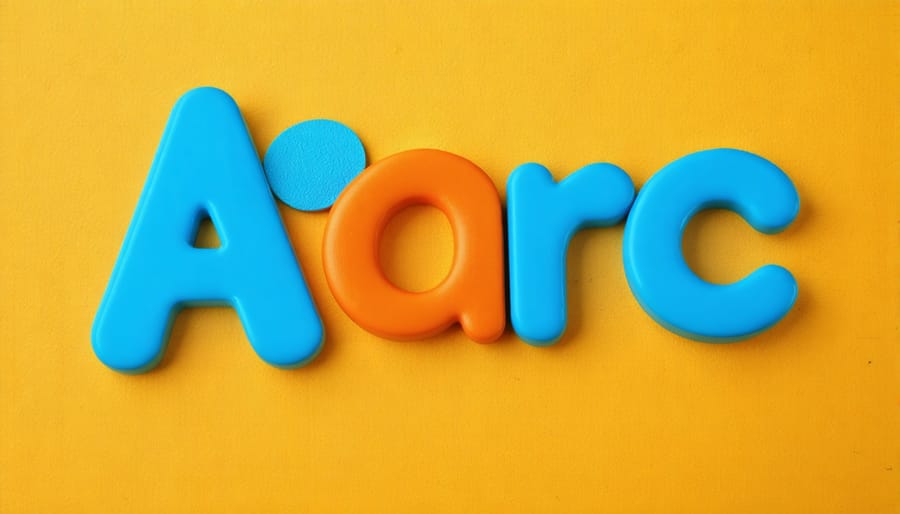
Hands-On Educational Games
Classroom Board Games
Classroom board games are fantastic tools for making learning fun and interactive for 5-year-olds. Games like “Count Your Way Home” and “Letter Land Adventure” combine entertainment with essential skills development. These games encourage turn-taking, following rules, and social interaction while reinforcing early math and literacy concepts.
Simple matching games using colorful cards help children practice memory skills and pattern recognition. “Animal Alphabet” lets little ones match letters to pictures, while “Number Path” introduces basic counting and number sequencing through an exciting board adventure.
The best part? Many of these games can be adapted to different learning levels. For instance, “Shape Sorters Board Race” can focus on basic shapes for beginners or include more complex patterns for advanced learners. Teachers can even create their own versions using classroom materials and familiar themes from current lessons.
Remember to keep game sessions short (10-15 minutes) and celebrate every child’s participation. This helps maintain engagement and builds confidence in young learners.
Interactive Memory Games
Memory games are perfect for developing cognitive skills in 5-year-olds while keeping them engaged and entertained. Start with classic matching card games using 6-8 pairs of colorful images like animals or shapes. As children progress, gradually increase the number of pairs to challenge their growing abilities.
A fun classroom adaptation is the “Moving Memory” game, where you arrange children in a circle and assign each a simple movement or sound. One child starts by performing their action and choosing another student’s action to repeat. Each subsequent child must remember and perform the growing sequence correctly.
Digital memory games on classroom tablets can offer exciting variations with adjustable difficulty levels. Look for apps featuring familiar objects, letters, or numbers that provide instant feedback and celebratory sounds for correct matches.
Create a “Memory Corner” in your classroom with rotating materials like picture cards, shape sorting games, and sequence puzzles. This allows children to practice independently during free play time. Remember to switch out materials every few weeks to maintain interest and introduce new challenges.
Always celebrate success and encourage persistence when children are learning these games. The key is to make memory-building fun rather than frustrating.
Making Educational Games Work in Your Classroom
Setting Up Game Stations
Creating engaging game stations in your classroom doesn’t have to be complicated! Start by dividing your space into 4-5 distinct areas, each dedicated to different types of educational activities. Use colorful tape or rugs to mark boundaries, making it easy for little ones to identify their designated play spaces.
Set up a cozy corner for puzzle stations with child-sized tables and chairs. Next to it, create a math zone with counting games and manipulatives. Include a literacy station with letter matching games and picture cards. Don’t forget a technology corner with a tablet or computer for educational apps, and a hands-on area for building blocks and sensory activities.
Keep materials organized in clear, labeled bins that are easily accessible to five-year-olds. Use picture labels alongside words to help them identify and return items independently. Rotate games weekly to maintain interest and target different skills.
Display simple instructions using pictures and basic words at each station. Consider using a rotation chart with students’ photos to manage turn-taking smoothly. Limit each station to 3-4 children to prevent overcrowding and ensure everyone gets hands-on time with the materials.
Remember to include cleanup time in your routine – make it fun by turning it into a quick sorting game! This teaches responsibility while keeping your stations organized for the next day.
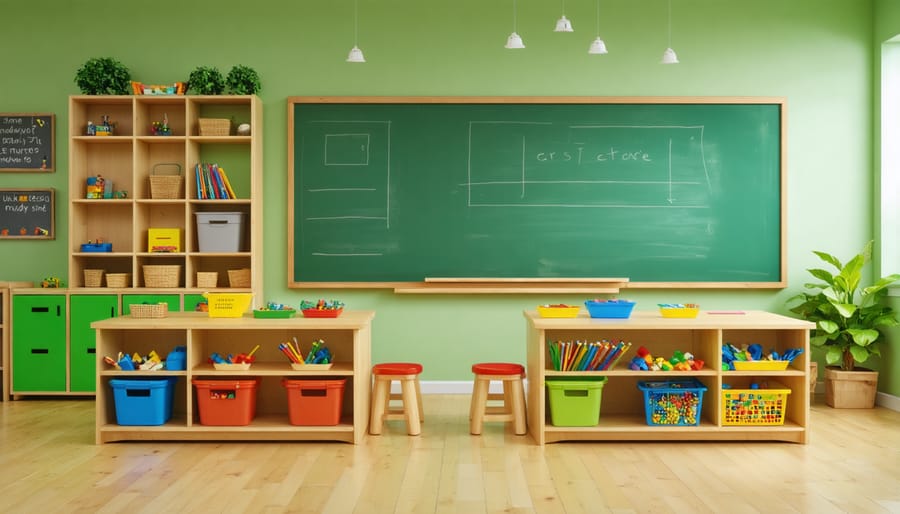
Assessment Through Play
Observing children during playtime provides valuable insights into their learning progress. As they engage with educational games, you can track development across multiple areas without formal testing. Keep a simple observation journal to note how children interact with number games, sorting activities, and pattern recognition tasks.
Watch for improvements in specific skills like counting sequence, shape recognition, or letter sounds during gameplay. For instance, if a child who previously struggled with counting to 10 now confidently plays number-matching games, that’s clear progress! Look for signs of growing confidence, increased attention span, and better social interactions during group games.
Create simple checklists for different learning objectives and tick them off as you observe mastery through play. You might notice a child successfully completing puzzles they found challenging before or using new vocabulary learned from word games. Remember to celebrate these small wins!
Document progress by taking photos or quick videos of children engaged in educational games. This visual record helps track improvement over time and provides wonderful examples to share with parents. Consider creating individual “learning through play” portfolios that showcase each child’s journey.
The beauty of assessment through play is that children remain relaxed and natural, giving you authentic insights into their development without the pressure of formal evaluation.
Educational games offer an invaluable pathway to engaging young minds while making learning a joyful experience. By incorporating these games into your classroom routine, you’ll create an environment where children eagerly participate in their own educational journey. Remember that the best results come from mixing different types of games – digital, physical, and creative – to keep students excited and motivated. The beauty of educational games lies in their flexibility; you can easily adapt them to suit your classroom’s unique needs and learning objectives. As you implement these games, you’ll notice improved student engagement, enhanced social skills, and stronger cognitive development. Start small, be consistent, and watch as your 5-year-olds flourish through the power of playful learning!
